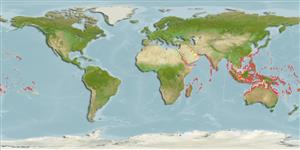Common names from other countries
Environment: milieu / climate zone / depth range / distribution range
Ecologia
marinhas associadas(os) a recifes; não migratória; intervalo de profundidade 0 - 30 m (Ref. 37816). Tropical; 30°N - 30°S, 30°E - 139°W
Indo-Pacific: Red Sea and East Africa to French Polynesia, north to the Ryukyu and Ogasawara islands, south to Queensland, Australia.
Comprimento de primeira maturação / Tamanho / Peso / Idade
Maturity: Lm ?, range 24 - ? cm
Max length : 40.0 cm SL macho/indeterminado; (Ref. 3503); common length : 27.0 cm TL macho/indeterminado; (Ref. 5450); peso máx. publicado: 2.4 kg (Ref. 11441)
Espinhos dorsais (total) : 12 - 14; Raios dorsais (total) : 5 - 7; Espinhos anais: 3; Raios anais : 5 - 6. Colors matching surroundings and extremely well-camouflaged (Ref. 48635). Pelvic and anal fins spines are similarly developed. 12-14 stout grooved spines, each with a large venom sack at its base (Ref. 37816).
Most widespread stonefish (Ref. 4313). Found on sandy or rubble areas of reef flats and shallow lagoons and in small pools during low tide well camouflaged among the substrate and sometimes even covered with algae (Ref. 5213, 5503). Solitary species (Ref. 37816). Feeds on fishes and crustaceans. The dorsal fin has 2 grooves serving as seringes of venom; their stings are excruciatingly painful and can occasionally be fatal. A serum exists which is effective if applied immediately after the infliction. World's most venomous fish (Ref. 37816). Uncommon in markets. In Hong Kong live fish markets (Ref. 27253). Also Ref. 57406.
Ciclo de vida ou comportamento de acasalamento
Maturities | Reprodução | Spawnings | Egg(s) | Fecundities | Larvas
Poss, S.G. and K.V. Rama Rao, 1984. Scorpaenidae. In W. Fischer and G. Bianchi (eds.) FAO species identification sheets for fishery purposes. Western Indian Ocean (Fishing Area 51). Vol. 4. FAO, Rome. pag. var. (Ref. 3503)
Status na Lista Vermelha da UICN (Ref. 130435)
CITES (Ref. 128078)
Not Evaluated
Uso pelos humanos
Pescarias: pouco comercial; Aquário: Espécies comerciais
Ferramentas
Relatórios especiais
Baixar XML
Fontes da internet
Estimates based on models
Preferred temperature (Ref.
115969): 24.9 - 29.3, mean 28.3 (based on 3300 cells).
Índice de diversidade filogenética (Ref.
82804): PD
50 = 0.5312 [Uniqueness, from 0.5 = low to 2.0 = high].
Bayesian length-weight: a=0.01622 (0.00609 - 0.04318), b=3.05 (2.82 - 3.28), in cm Total Length, based on LWR estimates for this (Sub)family-body shape (Ref.
93245).
Nível Trófico (Ref.
69278): 4.4 ±0.77 se; based on food items.
Resiliência (Ref.
120179): Baixo, tempo mínimo de duplicação da população 4,5 - 14 anos (Preliminary K or Fecundity.).
Fishing Vulnerability (Ref.
59153): Moderate vulnerability (39 of 100).
